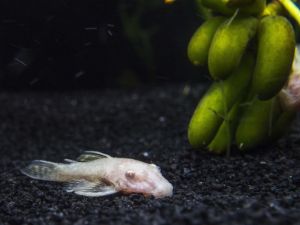
Albino Bushy Nose Pleco (Ancistrus sp.) is a member of the Loricariidae family of South American suckermouth catfishes

photo credit: Aquatic Arts
South American suckermouth catfish Loricariidae includes the Albino Bristlenose Pleco (Ancistrus dolichopterus), also called the Albino Bushynose or Bushymouth Pleco. This albino variety of Bushy Nose pleco is one of many popular color variants that have been developed for this popular "pleco" species in the aquarium hobby. Many suckermouth catfish species are yet to be bred on a large scale in aquariums. There are numerous bristle-like appendages on this fish's face that begin to grow in sub-adulthood, making it easily distinguishable from other fish. Males' appendages grow larger and longer than those of the females.
Albino Bristlenose Plecos are a great choice for most aquariums because they are peaceful and hardy. When compared to the more commonly seen common plecostomus (Hypostomus plecostomus) and the Trinidad Pleco (Hypostomus punctatus), the Albino Bristlenose Pleco grows to only 4 to 5 inches in length (10 to 13 cm). Because of its smaller size, the pleco can survive and thrive in an aquarium as small as 30 to 40 gallons with proper care. When it comes to male plecos, territorial disputes can be avoided by providing each fish with a large amount of space and hiding places. There is a chance that the Albino Bristlenose Pleco will prey on small shrimp fry, but it is unlikely. Bristlenose Plecos, on the other hand, are raised in the same pools where shrimp are.
It is mostly nocturnal, but the Albino Bristlenose Pleco will become active during the day in an aquarium with plenty of driftwood, rockwork, and other hiding places once it is established. However, while it is not known to consume large amounts of wood like some plecos (Panaque speciosum, etc.), supplemental wood may be beneficial to it in some cases (or bio-film on driftwood). A juvenile Albino Bristlenose Pleco will not bother most plants in the aquarium, but it will consume a lot of algae. Veggie wafers and pellets, such as high-quality vegetable flakes and sinking algae wafers, should be included in the diet of Albino Bristlenose Plecos. Shelled peas, spinach, zucchini, and cucumber are just some of the fresh vegetables it will enjoy. When fed in moderation, meaty treats like bloodworms can be beneficial as well. Too much meat/animal protein in this fish's diet can be harmful to both the fish and the aquarium's cleanliness.


$12.00
References
Albino Bushy Nose Pleco (Ancistrus sp.) is a member of the Loricariidae family of South American suckermouth catfishesAsian Stone Mini Catfish (Hara jerdoni) Their small size makes them perfect for small tanks - they only grow to a maximum of 1 1/2 inches in length
Banjo Catfish (Bunocephalus coracoideus) this catfish is popular because of its strange appearance
Bristlenose Pleco (Ancistrus sp.) is a member of the Loricariidae family of South American suckermouth catfishes
Corydoras sterbai (Sterba's Corydoras) are among the most popular of the numerous currently known species within the Corydora classification
L134 Leopard Frog the Imperial Tiger Pleco (Peckoltia compta) is a member of the Loricariidae family of South American suckermouth
L201 Snowball Pleco (Hypancistrus inspector) also known as the Orinoco Angel Pleco, is a member of the Loricariidae family of South American suckermouth catfishes
L333 King Tiger Pleco (Hypancistrus sp.) is primarily nocturnal, but will often become active during daytime hours once established in an aquarium with plenty of driftwood, rockwork
L340 Mega Clown AKA Imperial Tiger Pleco (Hypancistrus sp.)
Otocinclus Catfish known as Otto Cats, otos, or dwarf suckermouth catfish
Panda Cory Catfish (Corydoras panda) is a very animated, distinctively marked schooling fish that is perfect for the community and planted aquarium
Rio Ucayali Bristlenose Pleco is a member of the Loricariidae family of South American suckermouth catfishes. While many suckermouth catfish species have yet to be bred commercially in aquariums, the very rare Orange Spot Bristlenose Pleco is now available




